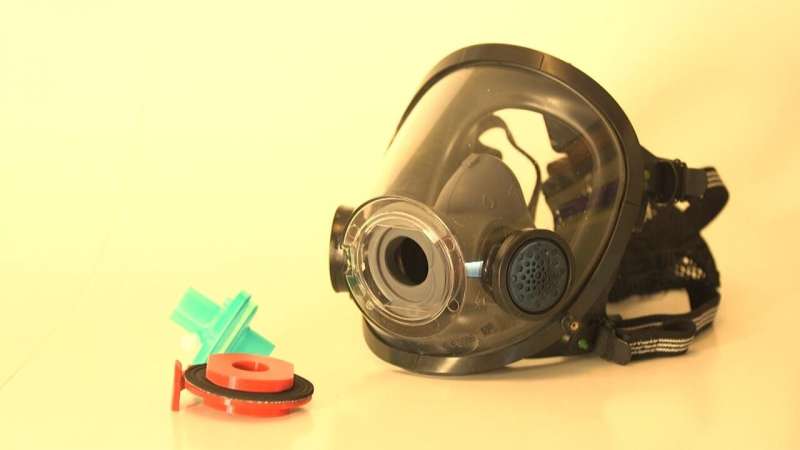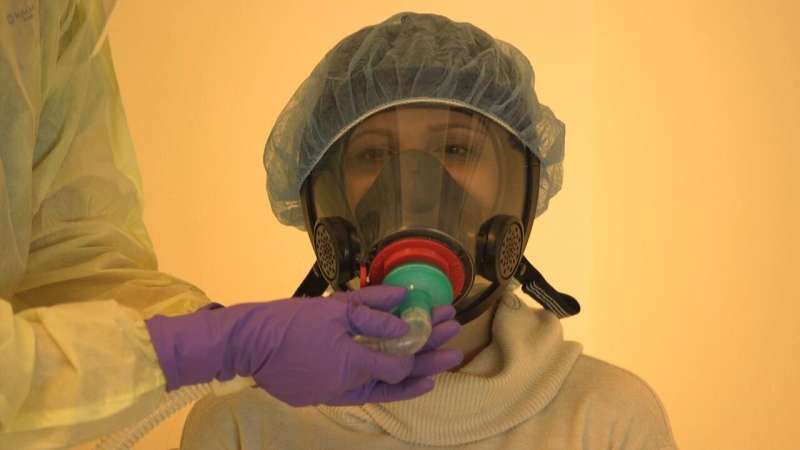New device could reduce COVID-19 infection risk and demand for invasive ventilators

Led by Lawson Health Research Institute, London Health Sciences Centre (LHSC), University Health Network (UHN) and General Dynamics Land Systems-Canada (GDLS-Canada), researchers have designed a non-invasive ventilation mask that could significantly reduce aerosolization—the production of airborne respiratory droplets that may contain viruses or bacteria—when treating patients with COVID-19. The new device aims to reduce infection risks associated with non-invasive ventilation and lessen the demand for invasive ventilators. It is currently being tested through a clinical trial with patients at LHSC.
"Since the beginning of this pandemic, there have been global concerns about a shortage of ventilators," says Dr. Tarek Loubani, Lawson Associate Scientist and Emergency Department Physician at LHSC. "Non-invasive ventilators like CPAP (continuous positive airway pressure) and BiPAP (bi-level positive airway pressure) machines are associated with an increased risk of COVID-19 transmission and so many hospitals have moved directly to invasive ventilation."
COVID-19 is primarily spread through inhalation of respiratory droplets and the most severely ill patients require a ventilator to help them breathe. Unlike invasive ventilators, which require intubation, non-invasive ventilators help patients breathe through a mask that provides positive pressure to keep the lungs open and functioning. While non-invasive ventilators may be effective for some COVID-19 patients, their use comes with a much higher risk of spreading infection through aerosolization of respiratory droplets.
The team's non-invasive ventilation mask aims to eliminate this risk. The novel device is customized from a standard firefighter's mask using 3-D printing and can be attached to any CPAP or BiPAP machine. Unlike traditional masks, it creates two tight seals—one around the patient's nose and mouth and another around the face. Patients breathe in and out of a filter that captures any viral particles before they are released to the air.

"There are countless CPAP and BiPAP machines idling around the world while all resources go towards invasive ventilation," explains Dr. Azad Mashari, Anesthesiologist at UHN's Peter Munk Cardiac Centre. "Our mask aims to put these machines back into the clinician's toolkit. By eliminating air leaks, we can improve patient safety and significantly reduce the risk of contracting COVID-19 for health-care workers and other patients."
Drs. Loubani, Mashari and Benjamin Thomson, Nephrologist at Mackenzie Health, were part of a clinical research team that worked with engineers from GDLS-Canada to develop the device within six days.
"GDLS-Canada responded quickly to the urgent need to support those on the COVID-19 healthcare frontlines during this global health emergency," says Doug Wilson-Hodge, GDLS-Canada's Manager of Communications, Community and Government Relations. "The innovative design was very much a collaborative effort between all parties to contribute solutions to the COVID-19 pandemic."
The initial clinical trial will test the device with up to 50 patients at LHSC's Victoria Hospital and University Hospital with plans to expand to UHN. In addition to patients with COVID-19, participants will include those with asthma, chronic obstructive pulmonary disease (COPD) and congestive heart failure (CHF).
The research team anticipates other hospitals in Ontario and across Canada will join the study to create a multi-centre clinical trial. The device will be used in emergency departments and has potential to be used in intensive care units, remote nursing stations and during pre-hospital transport. It has also been designed for easy production in resource-strained locations.
"This problem affects everyone and it's critical that we all do what we can to help," adds Dr. Loubani. "We hope it will help not only those in urban centres like Toronto and London, but people in remote communities around the world."
The trial is being supported with funding from Glia, an organization internationally recognized for producing medical supplies that are easily accessible and can be manufactured in low-resource settings.




















